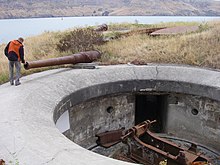Ripapa Island
Native name: Rīpapa (Māori) | |
|---|---|
 Fort Jervois | |
| Geography | |
| Coordinates | 43°37′12″S 172°45′16″E / 43.6201°S 172.7544°E |
| Administration | |
New Zealand | |
| Demographics | |
| Population | 0 |
| Official name | Fort Jervois |
| Designated | 22 August 1991 |
| Reference no. | 5306 |

Ripapa Island (
19th century Māori history
Ripapa Island was a perfect location for a
Quarantine station and prison
Between 1873 and 1885, the island was used as a
Fort Jervois


A walled fort, initially named Fort Ripa, was built on Ripapa in 1886 as part of a nationwide coastal defence system constructed due to the Russian scare, a fear that Russia would invade New Zealand. One of four fortifications set up to protect Lyttelton Harbour, it was renamed Fort Jervois after Lieutenant General Sir William Jervois in 1888. Four disappearing guns were installed by 1889. The fort was occupied by the New Zealand army until the end of World War I, during which it housed some prisoners of war, including Felix von Luckner.[5][7] It was again garrisoned during World War II.[6]
The fort is currently the home of two extremely rare guns. One is a
The island has been under the control of the Department of Conservation since 1990. Fort Jervois is classed as a Category I historic place by Heritage New Zealand,[5] and has been considered "actively managed" by the Department of Conservation.[6] It is the most complete Russian-scare fort still existing in New Zealand.[citation needed]
The June 2011 Christchurch earthquake damaged Fort Jervois and it was closed for some time. Remedial repairs were made, and the island reopened in November 2019,[8] with public ferry services from Lyttelton wharf resuming in 2020.[9]
See also
- History of the Canterbury Region
- Coastal fortifications of New Zealand
- List of islands of New Zealand
References
- ^ "Ripapa Island". New Zealand Gazetteer. Land Information New Zealand. Retrieved 14 December 2021.
- ^ "Ripapa – an ideal pa site". Department of Conservation. Retrieved 21 July 2022.
- ^ Weekes, John (9 February 2020). "Quarantined: A sordid, sickly, sad underside of New Zealand history". Stuff. Retrieved 16 February 2020.
- ^ The Taranaki Report: Kaupapa Tuatahi by the Waitangi Tribunal, chapter 7.
- ^ a b c "Fort Jervois". New Zealand Heritage List/Rārangi Kōrero. Heritage New Zealand. Retrieved 25 April 2011.
- ^ a b c "Ripapa Island Historic Reserve: History and culture". Department of Conservation. Retrieved 21 July 2022.
- ^ Munro, Robin (14 April 2012). "War hero or a braggart?". The Press. pp. C10–C11. Retrieved 19 October 2014.
- ^ "Historic Ripapa Island open for summer visitors". The Beehive. Retrieved 4 January 2020.
- ^ "Ripapa Island". Black Cat Cruises. 17 December 2019. Retrieved 4 January 2020.
External links
- Ripapa Island Historic Reserve, Department of Conservation

